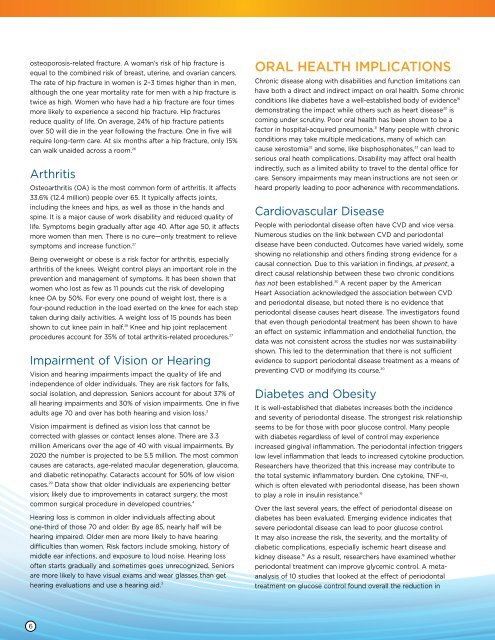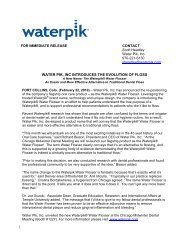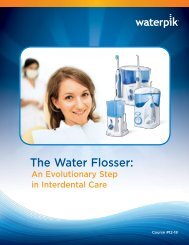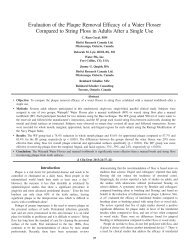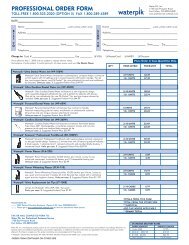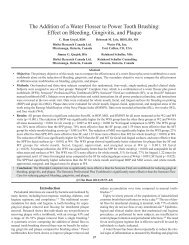Seniors and Boomers: Living Longer, Living Healthier ... - Waterpik
Seniors and Boomers: Living Longer, Living Healthier ... - Waterpik
Seniors and Boomers: Living Longer, Living Healthier ... - Waterpik
You also want an ePaper? Increase the reach of your titles
YUMPU automatically turns print PDFs into web optimized ePapers that Google loves.
osteoporosis-related fracture. A woman’s risk of hip fracture is<br />
equal to the combined risk of breast, uterine, <strong>and</strong> ovarian cancers.<br />
The rate of hip fracture in women is 2–3 times higher than in men,<br />
although the one year mortality rate for men with a hip fracture is<br />
twice as high. Women who have had a hip fracture are four times<br />
more likely to experience a second hip fracture. Hip fractures<br />
reduce quality of life. On average, 24% of hip fracture patients<br />
over 50 will die in the year following the fracture. One in five will<br />
require long-term care. At six months after a hip fracture, only 15%<br />
can walk unaided across a room. 26<br />
Arthritis<br />
Osteoarthritis (OA) is the most common form of arthritis. It affects<br />
33.6% (12.4 million) people over 65. It typically affects joints,<br />
including the knees <strong>and</strong> hips, as well as those in the h<strong>and</strong>s <strong>and</strong><br />
spine. It is a major cause of work disability <strong>and</strong> reduced quality of<br />
life. Symptoms begin gradually after age 40. After age 50, it affects<br />
more women than men. There is no cure—only treatment to relieve<br />
symptoms <strong>and</strong> increase function. 27<br />
Being overweight or obese is a risk factor for arthritis, especially<br />
arthritis of the knees. Weight control plays an important role in the<br />
prevention <strong>and</strong> management of symptoms. It has been shown that<br />
women who lost as few as 11 pounds cut the risk of developing<br />
knee OA by 50%. For every one pound of weight lost, there is a<br />
four-pound reduction in the load exerted on the knee for each step<br />
taken during daily activities. A weight loss of 15 pounds has been<br />
shown to cut knee pain in half. 28 Knee <strong>and</strong> hip joint replacement<br />
procedures account for 35% of total arthritis-related procedures. 27<br />
Impairment of Vision or Hearing<br />
Vision <strong>and</strong> hearing impairments impact the quality of life <strong>and</strong><br />
independence of older individuals. They are risk factors for falls,<br />
social isolation, <strong>and</strong> depression. <strong>Seniors</strong> account for about 37% of<br />
all hearing impairments <strong>and</strong> 30% of vision impairments. One in five<br />
adults age 70 <strong>and</strong> over has both hearing <strong>and</strong> vision loss. 3<br />
Vision impairment is defined as vision loss that cannot be<br />
corrected with glasses or contact lenses alone. There are 3.3<br />
million Americans over the age of 40 with visual impairments. By<br />
2020 the number is projected to be 5.5 million. The most common<br />
causes are cataracts, age-related macular degeneration, glaucoma,<br />
<strong>and</strong> diabetic retinopathy. Cataracts account for 50% of low vision<br />
cases. 29 Data show that older individuals are experiencing better<br />
vision; likely due to improvements in cataract surgery, the most<br />
common surgical procedure in developed countries. 4<br />
Hearing loss is common in older individuals affecting about<br />
one-third of those 70 <strong>and</strong> older. By age 85, nearly half will be<br />
hearing impaired. Older men are more likely to have hearing<br />
difficulties than women. Risk factors include smoking, history of<br />
middle ear infections, <strong>and</strong> exposure to loud noise. Hearing loss<br />
often starts gradually <strong>and</strong> sometimes goes unrecognized. <strong>Seniors</strong><br />
are more likely to have visual exams <strong>and</strong> wear glasses than get<br />
hearing evaluations <strong>and</strong> use a hearing aid. 3<br />
ORAL HEALTH IMPLICATIONS<br />
Chronic disease along with disabilities <strong>and</strong> function limitations can<br />
have both a direct <strong>and</strong> indirect impact on oral health. Some chronic<br />
conditions like diabetes have a well-established body of evidence 16<br />
demonstrating the impact while others such as heart disease 30 is<br />
coming under scrutiny. Poor oral health has been shown to be a<br />
factor in hospital-acquired pneumonia. 31 Many people with chronic<br />
conditions may take multiple medications, many of which can<br />
cause xerostomia 32 <strong>and</strong> some, like bisphosphonates, 33 can lead to<br />
serious oral heath complications. Disability may affect oral health<br />
indirectly, such as a limited ability to travel to the dental office for<br />
care. Sensory impairments may mean instructions are not seen or<br />
heard properly leading to poor adherence with recommendations.<br />
Cardiovascular Disease<br />
People with periodontal disease often have CVD <strong>and</strong> vice versa.<br />
Numerous studies on the link between CVD <strong>and</strong> periodontal<br />
disease have been conducted. Outcomes have varied widely, some<br />
showing no relationship <strong>and</strong> others finding strong evidence for a<br />
causal connection. Due to this variation in findings, at present, a<br />
direct causal relationship between these two chronic conditions<br />
has not been established. 30 A recent paper by the American<br />
Heart Association acknowledged the association between CVD<br />
<strong>and</strong> periodontal disease, but noted there is no evidence that<br />
periodontal disease causes heart disease. The investigators found<br />
that even though periodontal treatment has been shown to have<br />
an effect on systemic inflammation <strong>and</strong> endothelial function, the<br />
data was not consistent across the studies nor was sustainability<br />
shown. This led to the determination that there is not sufficient<br />
evidence to support periodontal disease treatment as a means of<br />
preventing CVD or modifying its course. 30<br />
Diabetes <strong>and</strong> Obesity<br />
It is well-established that diabetes increases both the incidence<br />
<strong>and</strong> severity of periodontal disease. The strongest risk relationship<br />
seems to be for those with poor glucose control. Many people<br />
with diabetes regardless of level of control may experience<br />
increased gingival inflammation. The periodontal infection triggers<br />
low level inflammation that leads to increased cytokine production.<br />
Researchers have theorized that this increase may contribute to<br />
the total systemic inflammatory burden. One cytokine, TNF-α,<br />
which is often elevated with periodontal disease, has been shown<br />
to play a role in insulin resistance. 16<br />
Over the last several years, the effect of periodontal disease on<br />
diabetes has been evaluated. Emerging evidence indicates that<br />
severe periodontal disease can lead to poor glucose control.<br />
It may also increase the risk, the severity, <strong>and</strong> the mortality of<br />
diabetic complications, especially ischemic heart disease <strong>and</strong><br />
kidney disease. 16 As a result, researchers have examined whether<br />
periodontal treatment can improve glycemic control. A metaanalysis<br />
of 10 studies that looked at the effect of periodontal<br />
treatment on glucose control found overall the reduction in<br />
6


